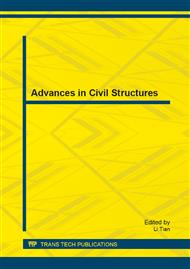p.156
p.164
p.169
p.174
p.179
p.191
p.195
p.199
p.203
Research on Dynamic Characteristics of Isolated System for Irregular Structures
Abstract:
This paper analyzes isolation questions of irregular structures, based on principles of structural isolation system. It also discusses present research and existing problems of translational torsion coupling isolated structures. Property parameters of layer unit are used to build up stiffness, mass and damping matrix of sway components, and dynamical calculation method of isolation system is explored when considering floor deformation. In this paper, the authors set up simplified calculation model for dynamic reaction of plane irregular buildings by using substructure method and taking floor as shear bending deep beam, quadratic displacement function and primary angle function are also used to describe floor movements. Time –history method is adopted to analyze dynamic responses of floor deformation for plane irregular buildings (T and U shapes).
Info:
Periodical:
Pages:
179-190
Citation:
Online since:
August 2013
Authors:
Price:
Сopyright:
© 2013 Trans Tech Publications Ltd. All Rights Reserved
Share:
Citation:


